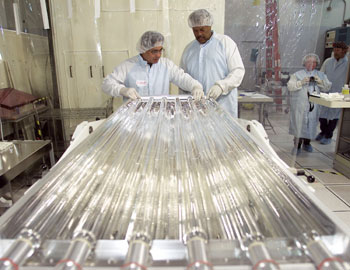Xenon flash lamp
|
|
Xenon-flash.gif
A xenon flash lamp is a gas discharge lamp designed to produce extremely intense, incoherent, full-spectrum white light for very short durations. The lamp is comprised of a sealed tube, often made of fused quartz, which is filled with a mixture of gases, primarily xenon, and electrodes to carry electrical current to the gas mixture. Additionally, a high voltage power source is necessary to energize the gas mixture; this high voltage is usually stored on a capacitor so as to allow very speedy delivery of very high current when the lamp is triggered. A flash is initiated by first ionizing the gas mixture, then sending a very large pulse of current through the ionized gas. Ionization is necessary to decrease the electrical resistance of the gas so that a very high current pulse, which can measure into the thousands of amperes, can travel through the tube. The initial ionization pulse, or trigger pulse, may be applied to one of the internal electrodes, or to a metal band or wire that is wrapped around the glass tube. When the trigger pulse is applied, the gas becomes ionized, and the capacitor immediately discharges through the tube. When this current pulse travels through the tube, it excites electrons surrounding the xenon atoms causing them to jump to higher energy levels. The atoms' electrons immediately drop back to a lower orbit, producing photons in the process. Depending on the size and application of the flashlamp, xenon fill pressures may range from a few kilopascals to tens of kilopascals (0.01–0.1 atmosphere or tens to hundreds of torr).
Xenon-flash-lamp.png
As with all relatively cold ionized gases, xenon flash lamps emit light in various spectral lines (see this spectrogram (http://www.sciencephotography.com/cgi-bin/emAlbum.cgi?cmd=show_image&path=science_04&img=163&tn=1)). This is the same phenomenon that gives neon signs their characteristic color. However, for xenon, there are enough spectral lines, and they are distributed across the spectrum in such a way, that to the human eye the light appears white. This is the primary motivation for selecting xenon as a filler in spite of its high cost; krypton is also occasionally used, although it is even more expensive.

Discharge durations for common flashlamps are in the microsecond to a few milliseconds range and can have repetition rates of hundreds of hertz. The glass envelope is most commonly a thin tube, which may be straight, or bent into a number of different shapes, including helical, "U" shape, and circular (to surround a camera lens for shadowless photography). The electrodes protrude into each end of the tube, and are connected to a capacitor that is charged to a relatively high voltage. This is usually between 100 and 2000 volts, depending on the length of the tube, and the specific gas mixture.
The flash that eminates from a xenon flash lamp may be so intense, that it can ignite flammable materials within a short distance of the tube. Carbon nanotubes are particularly susceptible to this spontaneous ignition when exposed to the light from a flashtube[1] (http://news.rpi.edu/update.do?artcenterkey=383&setappvar=page(1)). Similar effects may be exploited for use in aesthetic or medical procedures such as hair removal, tattoo removal and destroying lesions or moles.
Due to their high-intensity; relative brightness at short wavelengths (extending into the ultraviolet) and short pulsewidths, flashlamps are also ideally suited as light sources for pumping atoms in a laser to excited states where they can subsequently be stimulated to emit coherent monochromatic light.
Because the duration of the flash that is emitted by a xenon flash tube can be accurately controlled, and due to the high intensity of the light, xenon flash lamps are most commonly used as photographic strobe lights. Xenon flashlamps are also used in the technique of very high speed or "stop-motion" photography, which was pioneered by Harold Edgerton in the 1930s.
Template:ArtificialLightSources
